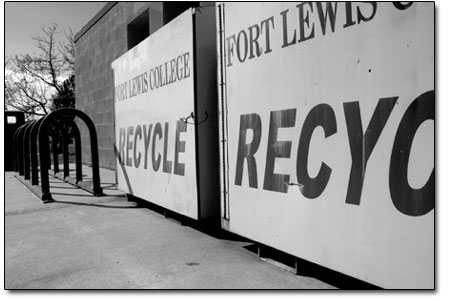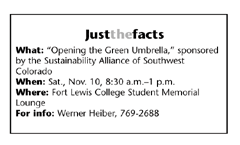| ||||||
| The greening of a campus FLC sets out on road to carbon neutrality SideStory: ‘Opening the Green Umbrella:’ Sustainability Alliance offers conference
by Missy Votel It’s inventory time at Fort Lewis College. But instead of taking stock of pens, paper and textbooks, the school is taking a detailed look at everything from bike racks and showerheads to food and even dumpsters – all with the goal of running a leaner, cleaner and greener ship. “We’re looking at everything from waste and recycling to campus food service and land and water use,” said Marcus Renner, director of the college’s Environmental Center. “We’re doing a top-to-bottom assessment of the college’s practices.” Renner said the information gathered will go toward forming a sustainability action plan for the school. Among other things, the plan would satisfy the American College & University Presidents Climate Commitment, signed by FLC President Brad Bartel last April, with the goal of becoming carbon neutral. “The data we gather can be put into a spreadsheet specially designed for campuses that will tell us how much CO2 we’re putting into the atmosphere and how we can get to net zero,” Renner said. Renner said he was inspired to develop a sustainability action plan for FLC after attending the Rocky Mountain Sustainability Conference at CU Boulder last February. “We heard about what other colleges are doing. This is where campuses are heading.” He said several prominent schools already have such plans, including Harvard University and Vermont’s Middlebury College, which has a goal of reaching carbon neutrality by 2016. Minnesota’s Carleton College even installed a wind turbine, which supplies 40 percent of the school’s electricity. Renner said sustainability action plans are good not only from a public relations standpoint, but an environmental and economic one as well. “This is something that FLC should do and how colleges will be evaluated on performance in years to come,” he said. “This is a great selling point for students. It can boost enrollment, which helps the bottom line for everybody, from the soccer team to the music department.” By cutting back on waste and resource usage, colleges employing sustainability plans can actually save money, he said. In turn, such savings can go back into a “revolving fund” for more energy efficient measures or to buy carbon offsets. “Not only do you do the right thing, but you save money for the college, which can be used to support other measures – such as buying solar panels or green power – that have a longer payback.” Helping the school develop its plan will be Woodard and Curran, an East Coast consulting firm specializing in sustainability plans for campuses. Renner said the company was chosen after a request for proposal last summer resulted in two bids, both of which were from out-of-town firms. Consultants from Woodard and Curran will be on campus next week to help with the sustainability audit, he said. However, for the last several weeks, FLC students and staff have been laying the groundwork for the plan by conducting research for the firm. “They sent us a 20-page questionnaire on the school’s usage habits, and we’ve been working all semester to collect the information,” he said.
For example, last month, Renner and students went dumpster diving to get a better handle on students’ recycling efforts, and lack thereof. They sorted through 176 pounds of garbage and found that more than 55 percent of waste was either recyclable or compostable. One item in particular seemed to be in great supply. “We found a huge number of coffee cups,” he said. “So that tells us that one area where we could improve is finding a way to reduce coffee cups.” Meanwhile, another student conducted an impromptu study that found that only 35 percent of the spots on the school’s 77 bicycle racks are being used on a typical day. Other studies took a look at the school’s utility bills, hazardous waste disposal, water usage and commuter patterns. “We’ve been working really hard to collect all this information,” Renner said. Using the information gathered by the school, as well as their own assessments, the consultants will be able to paint a more accurate picture of where the school stands. And from that baseline, they can form a sustainability action plan suited specifically to the school’s needs. However, Renner noted that the information gathered will be helpful not just to the school, but the community at large. For example, the commuter study may help the city and county as they undertake a larger transportation study. “The data could be useful for them in understanding where students are coming from,” he said. Furthermore, the school’s plan may also be helpful as the county and city conduct sustainability studies and audits of their own. “The hope is that our plan will help everybody and be integrated into everything we do,” he said. “It can have wide impacts that we don’t even think about right now.” Although the recommendations for the sustainability plan are not expected back from the consultants until the end of the year, Renner said the school is already embracing the concept in new construction, including the planned $30 million, 9,000-square-foot Student Union Building. “A huge area for improvement is in energy usage,” he said. “With such an old building stock, there are big gains to be made, and the Student Union Building is a huge part of that.” Renner said the school has been working with architects to incorporate passive solar, nontoxic building materials and ways to reduce and clean storm water run-off. Although there are no promises, he said the ultimate goal is a Gold Leadership in Energy and Environmental Design (LEED) rating for the building, making it among only a handful of buildings in the state with such a certification. “We’d be the greenest building in the Four Corners area,” he said. “It’s really exciting to think about.” In the meantime, Renner said the school has its work cut out for it. Starting next semester, the consultant recommendations will be explored in depth by students and faculty in study circles. From there, the draft action plan will be hammered out. “In some ways, that’ll be the most difficult part,” he said. “We have to make sure it is a living document and that it doesn’t just sit on a shelf, but embodies the goals and dreams of the people that make up the FLC community.” •
|
In this week's issue...
- January 25, 2024
- Bagging it
State plastic bag ban is in full effect, but enforcement varies
- January 26, 2024
- Paper chase
The Sneer is back – and no we’re not talking about Billy Idol’s comeback tour.
- January 11, 2024
- High and dry
New state climate report projects continued warming, declining streamflows




